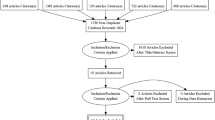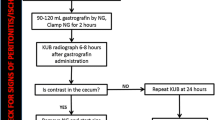Abstract
Objective
The aim of this study was to compare the computed tomographic colonography (CTC) image quality and patient acceptance of three iodine-based faecal tagging bowel preparations in 60 patients undergoing the following regimens: a 2-day regimen of meal-time administration of iodine and phospho-soda (GFPH); a 2-day regimen of meal-time mild laxative, followed by iodine administered 2 h before CTC (SD); and a 2-day regimen of meal-time administration of iodine (GF).
Methods
Two independent radiologists assessed tagging quality; quantitative measures included the tagged stool density, and computer-aided detection (CAD) false-positive rate.
Results
The GFPH and SD regimens provided better subjective quality than GF (p < 0.001). The latter regimen resulted in a higher proportion of insufficiently tagged segments: the measured average stool density was less than 200 HU in 10.7% in all segments vs 3.6% for SD and <0.5% for GFPH, respectively. Insufficient tagging occurred mostly in the ascending colon and the caecum. The CAD false-positive rate increased following the trend: GFPH < SD < GF (p = 0.00012). GFPH was worse tolerated than SD (p < 0.05).
Conclusions
Considering preparation quality alone, GFPH was the best regimen, but SD provided the best balance between bowel preparation quality and patient acceptability.









Similar content being viewed by others
References
Pickhardt PJ, Choi JR, Hwang I et al (2003) Computed tomographic virtual colonoscopy to screen for colorectal neoplasia in asymptomatic adults. N Engl J Med 349:2191–2200
Kim DH, Pickhardt PJ, Taylor AJ et al (2007) CT colonography versus colonoscopy for the detection of advanced neoplasia. N Engl J Med 357:1403–1412
Levin B, Lieberman DA, McFarland B et al (2008) Screening and surveillance for the early detection of colorectal cancer and adenomatous polyps, 2008: a joint guideline from the American Cancer Society, the US Multi-Society Task Force on Colorectal Cancer, and the American College of Radiology. CA Cancer J Clin 58:130–160
Johnson CD, Chen MH, Toledano AY et al (2008) Accuracy of CT colonography for detection of large adenomas and cancers. N Engl J Med 359:1207–1217
Beebe TJ, Johnson CD, Stoner SM, Anderson KJ, Limburg PJ (2007) Assessing attitudes toward laxative preparation in colorectal cancer screening and effects on future testing: potential receptivity to computed tomographic colonography. Mayo Clin Proc 82:666–671
Pickhardt PJ (2007) Colonic preparation for computer tomographic colonography: understanding the relative advantages and disadvantages of a noncathartic approach. Mayo Clin Proc 82:659–661
Lefere PA, Gryspeerdt SS, Dewyspelaere J et al (2002) Dietary fecal tagging as a cleansing method before CT colonography: initial results-polyp detection and patient acceptance. Radiology 224:393–403
Gryspeerdt S, Lefere P, Herman M et al (2005) CT colonography with fecal tagging after incomplete colonoscopy. Eur Radiol 15:1192–1202
Callstrom MR, Johnson CD, Fletcher JG et al (2001) CT colonography without cathartic preparation: feasibility study. Radiology 219:693–698
Iannaccone R, Laghi A, Catalano C et al (2004) Computed tomographic colonography without cathartic preparation for the detection of colorectal polyps. Gastroenterology 127:1300–1311
Lefere P, Gryspeerdt S, Marrannes J et al (2005) CT colonography after fecal tagging with a reduced cathartic cleansing and a reduced volume of barium. AJR Am J Roentgenol 184:1836–1842
Kim DH, Pickhardt PJ, Hinshaw JL et al (2007) Prospective blinded trial comparing 45-mL and 90-mL doses of oral sodium phosphate for bowel preparation before computed tomographic colonography. J Comput Assist Tomogr 31:53–58
Thomeer M, Bielen D, Vanbeckevoort D et al (2002) Patient acceptance for CT colonography: what is the real issue? Eur Radiol 12:1410–1415
Zalis ME, Perumpillichira J, Magee C (2006) Tagging-based, electronically cleansed CT colonography: evaluation of patient comfort and image readability. Radiology 239:149–159
Neri E, Turini F, Cerri F, Vagli P, Bartolozzi C (2008) CT colonography: same-day tagging regimen with iodixanol and reduced cathartic preparation. Abdom Imaging. doi:10.1007/s00261-008-9453-z
Taylor SA, Slater A, Burling DN et al (2008) CT colonography: optimisation, diagnostic performance and patient acceptability of reduced-laxative regimens using barium-based faecal tagging. Eur Radiol 18:32–42
Katayama H, Yamaguchi K, Kozuka T, Takashima T, Seez P, Matsuura K (1990) Adverse reactions to ionic and non ionic contrast media: a report from the Japanese Committee on the Safety of Contrast Media. Radiology 175:621–628
Skucas J (1997) Anaphylactoid reactions with gastrointestinal contrast media. AJR Am J Roentgenol 168:962–964
Taylor SA, Laghi A, Lefere P, Halligan S, Stoker J (2007) European society of gastrointestinal and abdominal radiology (ESGAR): consensus statement on CT colonography. Eur Radiol 17:575–579
Zalis ME, Perumpillichira J, Del Frate C, Hahn PF (2003) CT Colonography: digital subtraction bowel cleansing with mucosal reconstruction—initial observations. Radiology 226:911–917
Jensch S, de Vries AH, Pot D et al (2008) Image quality and patient acceptance of four regimens with different amount of mild laxatives for CT colonography. Am J Roentgenol 191:158–167
Slater A, Taylor SA, Burling D et al (2006) Colonic polyps: effect of attenuation of tagged fluid and viewing windows on conspicuity and measurement—in vitro experiment with porcine colonic specimen. Radiology 240:101–109
Yoshida H, Nappi J (2007) CAD in CT colonography without and with oral contrast agents: progress and challenges. Comput Med Imaging Graph 31:267–284
Delsanto S, Morra L, Agliozzo S et al (2008) Computer aided detection of polyps in virtual colonoscopy with sameday faecal tagging. Proc SPIE Medical Imaging 6915-28
Chan Y, Walmsley RP (1997) Learning and understanding the Kruskal-Wallis One-way analysis-of-variance-by-ranks test for differences among three or more independent groups. Phys Ther 77:1755–1761
Sprent P, Smeeton NC (2001) Applied nonparametric statistical methods, 3rd edn. Chapman & Hall/CRC, London
Kundel HL, Polansky M (2003) Measurement of observer agreement. Radiology 228:303–308
Campanella D, Morra L, Delsanto S, Gallo TM, Tartaglia V, Regge D (2008) Quantitative quality assessment of different faecal tagging (FT) CT colonography (CTC) preparations. Eur Radiol 18(Suppl 1):B-363
Acknowledgements
We thank im3D S.p.A. (Torino, Italy) for providing viewing software, technical support and statistical consultancy for this study.
Author information
Authors and Affiliations
Corresponding author
Rights and permissions
About this article
Cite this article
Campanella, D., Morra, L., Delsanto, S. et al. Comparison of three different iodine-based bowel regimens for CT colonography. Eur Radiol 20, 348–358 (2010). https://doi.org/10.1007/s00330-009-1553-9
Received:
Accepted:
Published:
Issue Date:
DOI: https://doi.org/10.1007/s00330-009-1553-9




